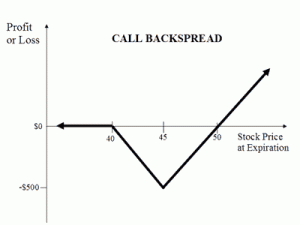The call backspread is an investment strategy that involves selling a call at one strike price at a lower rate and then purchasing two calls at a higher strike price. This approach provides the call ratio backspread with a built in hedge component that is very likely to result in breaking even for the investor, and possible even realizing a small profit. The call backspread (reverse call ratio spread) is a bullish strategy in options trading whereby the options trader writes a number of call options and buys more call options of the same underlying stock and expiration date but at a higher strike price. It is an unlimited profit, limited risk strategy that is used when the trader thinks that the price of the underlying stock will rise sharply in the near future.
The call back spread profits when the stock price makes a strong move to the upside beyond the upper breakeven point. There is no limit to the maximum possible profit.
The formula for calculating profit is given below:
- Maximum Profit = Unlimited
- Profit Achieved When Price of Underlying >= 2 x Strike Price of Long Call – Strike Price of Short Call +/- Net Premium Paid/Received
- Profit = Price of Underlying – Strike Price of Long Call – Max Loss
The backspread is the converse strategy to the ratio spread and is also known as reverse ratio spread. Using calls, a bullish strategy known as the call backspread can be constructed and with puts, a strategy known as the put backspread can be constructed.
Similar to a Short Straddle except the loss on the downside is limited.
When to use
When you are bullish on volatility and bullish on market price. Note though, that you profit when prices fall, although the gains are greater if the market rallies.
A Backspread looks a lot like a Long Straddle except the payoff flattens out on the downside. The other key difference is that Backspreads are usually done at a credit. That is, the net difference for both legs means that you receive money into your account up front instead of paying (debit) for the spread.
Even though the payoff looks like a “long” type position, it is often referred to as a “short” strategy. Generally it is like this: if you receive money for the position up front it is called a “Short” position and when you pay for a position it is called being “Long”.
